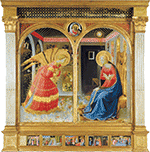Annunciation
Fra Angelico’s Annunciation, together with Masaccio’s Triptych of San Giovenale, is undoubtedly one of the most precious works to come from the Valdarno territory and to be shown in the Renaissance in Valdarno exhibition.
Coming from the Franciscan Convent of Montecarlo, it is thought to have originally been intended for the congregation of the Servants of Mary at Sant’Alessandro in Brescia, although it was never delivered there. In 1630, arbitrary and disfiguring cuts were made to reduce the size of the painting so that it would fit the Baroque frame selected by the small Valdarno convent. The heavy repainting of some parts is almost certainly coeval. The work was returned to its original dimensions only at the beginning of the 20th century, coinciding with Poggi’s first attribution of the work to Fra Angelico.
The dating of the work has been placed somewhere between 1430 and 1440, by comparing it to the Annunciation from San Domenico in Fiesole (today in the Prado), which is considered an early work, and the later Annunciation in Cortona. In any case, it may be placed at a point when the artist was passing from an early stage to a more mature one. The scene takes place in a portico, with the figures depicted using a rich and bright range of colors; the spiritual tension that enlivens them is palpable and moving, even though “the profundity of the message, together with the subtle allusiveness of each detail never weigh down Fra Angelico’s works, all perfectly enjoyable and fresh in their invitation to a clear, balanced religiosity”. (Caneva).
This work stands out for the extraordinary quality
of its colors, the imagination and elegance of the
decorations and details shown that attest to Fra
Angelico’s experience in the precious art of
illumination. The richly adorned and elegant figures
echo the colors of Lorenzo Monaco, the refinement of
Gentile da Fabriano, the naturalness of Masolino,
succeeding in expressing, as probably no other
interpreter of the Renaissance was able to do, a
“balanced and serene [reality], seeking to interpret it
in a unified manner according to the humanistic
conception that placed man at the center of all
things”. (Caneva)

Fra Angelico, Annunciation, Museum of the Basilica of Santa Maria delle Grazie in San Giovanni Valdarno. On the predella, stories from the life of the Virgin: the Wedding, the Visitation, the Adoration of the Magi, Presentation at the Temple, and the Dormitio Virginis. 1430-1432 or towards 1440; tempera on a wooden panel; 195 x 158 cm; predella sections; 16 × 30 cm each